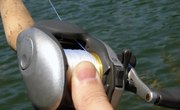Penn makes two types of reels that anglers often use for casting -- spinning reels and baitcasting reels. The two reel types are available in a variety of sizes and suit fishermen targeting freshwater or saltwater fish species. As a general rule, anglers fishing for large fish use baitcasting reels, while those targeting smaller fish species use spinning reels. Before they go fish, anglers should practice casting so they will be proficient at it.
Items you will need
Fishing rod
Line
Lure
Spinning Reel
Grip the rod and reel with your dominant hand. The area where the reel meets the rod should be between your middle and ring fingers.
Hold the fishing line where it leaves the reel with your index finger on your dominant hand.
Flip open the bail on the Penn reel.
Bring the rod and reel over your shoulder in a casting motion, and then bring it forward. Release the line from your index finger when the rod tip moves beyond your shoulder.
Close the bail once the lure hits the water and then begin reeling it in.
Baitcasting Reel
Set the reel's spool tension by turning the knob that's located on the same side of the reel as the handle. Turning the knob clockwise increases the tension, while turning it counterclockwise decreases the tension and allows the spool to spin more freely. To test the tension, tie a lure to the end of the fishing line and press down on the thumb bar, allowing the lure to fall to the ground. If the tension is set properly, the spool will stop spinning when the lure hits the ground. If the lure does not hit the ground, decrease the tension. If it hits the ground and the spool continues spinning, increase the tension.
Set the reel's brake system. On some Penn reels with magnetic brakes, the system can be controlled via a dial on the side of the reel opposite the handle. Turning the dial counterclockwise allows you to cast further, but increases the risk of backlash. Turning the dial clockwise decreases the risk of backlash, but also decreases casting distance. A good place to start is to set the dial in the middle and then turn the dial counterclockwise as you become comfortable casting the reel. Other Penn reels have a centrifugal brake system that's controlled by pins inside the reel. To adjust it, find the screws or small knobs on the side of the reel opposite the handle and loosen them until you can remove the side of the reel. You will see pins running out from the center of the reel. Press down half of the pins to start with. Press them all down when you are more comfortable casting the reel.
Hold the rod just below the reel with your dominant hand, and place your thumb on the reel's thumb bar.
Grip the butt end of the rod with your other hand.
Press down on the reel's thumb bar with your thumb, and use your thumb to put pressure on the line spool to stop it from spinning.
Bring the rod back over your shoulder in a casting motion, and then bring it forward. As the rod tip travels beyond your shoulder, release your thumb from the line spool.
Place your thumb back on the line spool as the lure falls toward the water. Apply pressure just before the lure hits the water.
References
Writer Bio
Larry Anderson has been a freelance writer since 2000. He has covered a wide variety of topics, from golf and baseball to hunting and fishing. His work has appeared in numerous print and online publications, including "Fargo Forum" newspaper. Anderson holds a Bachelor of Arts in print journalism from Concordia College.



